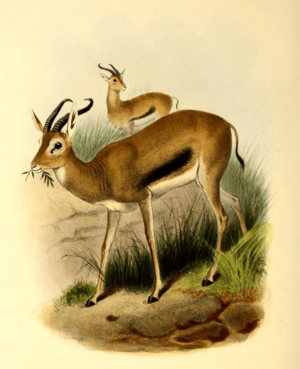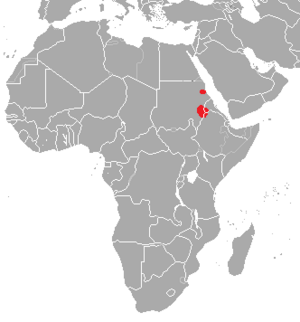Heuglin's gazelle facts for kids
Quick facts for kids Eritrean gazelle |
|
|---|---|
 |
|
| Illustration by Philip Sclater in The Book of Antelopes (1894) | |
| Conservation status | |
| Scientific classification | |
| Genus: |
Eudorcas
|
| Species: |
tilonura
|
 |
|
| Heuglin's gazelle range | |
The Eritrean gazelle (Eudorcas tilonura), also known as Heuglin's gazelle, is a type of gazelle. You can find it in parts of Eritrea, Ethiopia, and Sudan, east of the Nile River. People used to think it was a subspecies of other gazelles, like the red-fronted gazelle or Thomson's gazelle. However, scientists now agree it's its own unique species.
This small gazelle stands about 67 centimeters (26 inches) tall at the shoulder. It weighs between 15 and 35 kilograms (33 to 77 pounds). Its fur is a dark reddish-brown. It has a dark reddish stripe along its sides. Its belly and rump are white. Both male and female Eritrean gazelles have horns. These horns are usually 15 to 35 centimeters (6 to 14 inches) long.
Not much is known about how these gazelles live. They usually live alone or in small groups of two to four. They eat plants, probably both by browsing on leaves and grazing on grass. A female gazelle is pregnant for about six months. After this, she likely gives birth to one calf. Eritrean gazelles live in open areas. These include steppes, dry grasslands, and thorny bushlands. They can live at heights up to 1,400 meters (4,600 feet).
Sadly, these gazelles are in danger. Their homes are being destroyed. Also, people hunt them illegally for their meat. Their numbers have dropped a lot. As of 2016, there were only about 2,500 to 3,500 Eritrean gazelles left. They live in small, separate groups. Because of this, the Eritrean gazelle is listed as an Endangered animal by the IUCN Red List.
Contents
About the Eritrean Gazelle
The Eritrean gazelle is smaller than many other types of gazelles. Males and females look quite similar. Their horns are shorter and thinner compared to other gazelles.
Size and Appearance
These gazelles are 55 to 120 centimeters (22 to 47 inches) long from head to body. They stand about 67 centimeters (26 inches) tall at the shoulder. Males are a bit heavier, weighing 20 to 35 kilograms (44 to 77 pounds). Females weigh 15 to 25 kilograms (33 to 55 pounds).
Their fur is dark reddish-brown. Their belly and rump are white. They have a dark reddish stripe on their sides. Their face is darker in the middle. They also have white rings around their eyes.
Horns
Both male and female Eritrean gazelles have horns. Male horns are 22 to 35 centimeters (9 to 14 inches) long. Female horns are 15 to 25 centimeters (6 to 10 inches) long. The tips of their horns curve inward. Female horns are thinner and straighter than male horns.
The tail is 15 to 27 centimeters (6 to 11 inches) long. It is reddish at the base and turns black towards the end. The Eritrean gazelle is smaller and more reddish than the red-fronted gazelle. Its nose does not have any markings. The Dorcas gazelle, which lives in some of the same areas, has a lighter reddish stripe. The larger and paler Soemmerring's gazelle also shares its home with the Eritrean gazelle in southwestern Eritrea. Soemmerring's gazelle has short, heavy horns that curve backward. Its rump is whiter, and its tail has short white hairs.
Life and Habits
Eritrean gazelles usually live alone or in very small groups. These groups often have only two to four animals.
Resting and Marking
During the hottest part of the day, they dig shallow spots in the ground to rest. They often do this under bushes or large trees. Examples include the Egyptian balsam tree in savannahs or Vachellia nubica in shrublands. If a group of gazelles rests in the same spot for a long time, you might see many dung piles there.
Scientists don't know much about how these gazelles claim their territory in the wild. However, male gazelles in zoos make dung piles near fences. They smell and scratch the ground nearby before pooping. They also use special glands near their eyes, called Preorbital glands, to mark things.
Diet
Eritrean gazelles are herbivores, meaning they eat plants. They probably eat both leaves from bushes (browsing) and grass (grazing). Even though they can go without water for a while, they need water more often than some other gazelles in their area.
Reproduction
When gazelles mate, it only lasts a few seconds. The male stands on his back legs and mounts the female. The female is pregnant for about 184 to 189 days (around six months). After this, she most likely gives birth to one calf. Most births happen during the wet season. Young gazelles might be hunted by Jackals. Hyaenas could also be predators.
Where They Live
The Eritrean gazelle lives in a few scattered areas east of the Nile River. Their home range is bordered by the southern Red Sea Hills in Sudan. It also includes mountainous areas in northwestern Ethiopia and western Eritrea.
These gazelles prefer open spaces. They live in steppes, dry grasslands, and thorny bushlands. They can be found at elevations up to 1,400 meters (4,600 feet).
Population Status
Not much is known about how many Eritrean gazelles there are. Their numbers have dropped sharply in Eritrea. However, in 2019, the wildlife authority in Eritrea announced that Eritrean gazelles had been seen again. This was in the Dige sub-zone of the Gash-Barka Region. It was exciting news because the gazelle was last seen in Eritrea during the time of Italian colonial rule (in the 19th and 20th centuries).
Dangers and Protection
The IUCN Red List has classified the Eritrean gazelle as Endangered. This means they are at a very high risk of becoming extinct.
Threats
Experts believe their numbers might have dropped by 20% in just nine years after 2008. As of 2016, there were only 2,500 to 3,500 individuals left. Fewer than 2,500 of these were adults.
The biggest dangers to the Eritrean gazelle are:
- Habitat loss: Their natural homes are being destroyed. This happens because of too much overgrazing by livestock, cutting down trees (deforestation), and turning land into farms (agricultural expansion). Droughts also make their habitat worse.
- Illegal hunting: People hunt these gazelles illegally for their meat.
Conservation Efforts
Eritrean gazelles live in several protected areas. These include:
- Gash-Setit in Eritrea
- Kafta Sheraro National Park (and possibly Alatash National Park) in Ethiopia
- Dinder National Park in Sudan
However, even in protected areas, they face challenges. In Dinder National Park, they are often hunted. This is especially true in the wet season when they cross the park's borders. Also, in the dry season, camel and goat herders often bring their animals into the park. Their animals eat the plants, leaving less food and fewer resting spots for the gazelles.


